KPnetBlogs bringer en spændende rejseberetning som sommerføljeton i 7 dele skrevet af Ron Ridenour med collager af Jette Salling. De to har besøgt Spanien og videregiver her tanker og indtryk fra landet – om politikken, historien, naturen og menneskene de har mødt. Teksten er på engelsk
Her følger 1. afsnit samt en introduktion (også oversat til dansk).
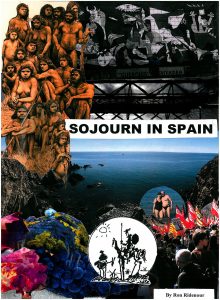 Cover: Heidelbergensis people likeness 400,000 year ago, Picasso’s Guernica massacre, Viscaya Bridge, Cabo de Gata cliffs into sea, Jette and Ron ready to swim, Spanish wine grapes, Cervantes Don Quixote, student general strike.
Cover: Heidelbergensis people likeness 400,000 year ago, Picasso’s Guernica massacre, Viscaya Bridge, Cabo de Gata cliffs into sea, Jette and Ron ready to swim, Spanish wine grapes, Cervantes Don Quixote, student general strike.
By Ron Ridenour
Collages by Jette Salling
Table of Contents
Introduction
1. Costa del Sol, Hating America, Muslims, Corruption, Dolmens—page 2
2. Art, war and peace –page 11
3. Almería and Podemos –page 15
4. Barcelona, Catalonia sovereignty, and civil war –page 20
5. Basque Country: Bilbao, San Sebastian, Gernika –page 24
6. Atapuerca UNESCO world heritage site: Who are we? –page 32
7. Madrid and conclusion –page 37
Fra introduktionen
Mens vi nød den helsebringende sol langt fra det grå Danmark iagttog min kæreste Jette og jeg vigtige udviklinger, mens vi rejste gennem Spanien i årets to første måneder.
Vi så gamle gravsteder og geologiske ejendommeligheder og besteg bjerge hvor vi indsnusede den rige flora. Vi boede i syd, øst og nord fra Fuengirola, Mijas, Antequera, Granada, Málaga (Picasso’s hjemby) til Almería, Barcelona, Bilbao, San Sebastian, Guernica, Burgos-Atapuerca og Madrid.
Vi talte med folk fra ETA (Euskadi Ta Askatasuna/Basque Homeland and Freedom) netop da organisationen nedlagde våbnene 58 år efter dens dannelse. Tre katalonske politiske ledere blev dømt for ulydighed mod den spanske forfatning, da de kaldte en symbolsk folkeafstemning for retfærdig. Dommerne advarede også den nye regionale regering imod en sådan folkeafstemning. Podemos – der pludselig var det trediestørste politiske parti med 21 % af stemmerne – dukkede op fra den interne debat med en ledelse der pegede i reformistisk retning.
Vi fik også viden om de forbløffende videnskabelige opdagelser omkring Europas tidligst identificerede folk, Homo antecessor der er fundet ved Sierra de Atapuerca og om de unikke Homo heidelbergensis, og en 1,3 millioner år gammel kæbe fra et endnu ikke identificeret individ. Mange af disse fossiler er offentligt tilgængelige i det nærliggende Museum for menneskelig udvikling.
Introduction
Concomitant with soaking in the healing sun far from grey Denmark, my sweetheart Jette and I witnessed important developments as we traveled through Spain the first two months of 2017.
We observed ancient grave sites and geological peculiarities, and hiked mountains inhaling the rich botany. We lived in or visited the south, east and north from Fuengirola, Mijas, Antequera, Granada, Málaga (Picasso’s hometown) to Almería, Barcelona, Bilbao, San Sebastian, Guernica, Burgos-Atapuerca, and Madrid.
We spoke with people involved in the ETA (Euskadi Ta Askatasuna/Basque Homeland and Freedom) as it was surrendering its weapons 58 years after its formation. Three Catalonia’s political leaders were sentenced for disobeying Spain’s constitution by calling for a symbolic referendum just. The judges also warned the new Catalonian regional government against any such referendum. Podemos—suddenly the third largest political party with 21% of vote—emerged from internal debate with a united leadership pointing in a reformist direction.
Moreover, we learned of amazing scientific discoveries of Europe’s earliest identified people, Homo antecessor (Explorer), found at Sierra de Atapuerca. Fossils were also found of the uniquely caring Homo heidelbergensis, and a 1.3 million year-old jawbone of an as yet unidentified hominid. Many of these fossils are on public display in the nearby Burgos Museum of Human Evolution.
1. Costa del Sol, Hating America, Muslims, Corruption, Dolmens
Randy Shields, a witty, searing Philadelphia writer and musician, and I share a hatred for the United States of America. We hate its self-perceived “exceptionalism”, which it uses as an excuse to lucratively invade half the world’s countries, murdering millions of people and torturing hundreds of thousands.(1)
“I’m gonna take 60 days off from hating America to enjoy the sun in Spain and do my best to avoid writing about any of it.” Randy: “Trip to Spain sounds great but it is possible to hate America from anywhere!”
Randy was right, of course. I couldn’t avoid hating USamerica and neither could I, as this piece proves, avoid writing about it—a poor substitute for effectively acting to stop its killing machine.
The evening after arriving at our pension-affordable rental apartment in Fuengirola, we watched a lively Flamenco dance group while eating a marvelous seafood dinner at a popular restaurant. Next morning, we ate breakfast on our terrace facing the Sohail Castle (meaning “star” in Arabic) so named by the Caliphate of Córdaba when Arabs dominated Andalusia. This watchtower-fort-castle was built on the hill in the 11th century. We took a relaxing swim in the wonderfully clear blue Mediterranean Sea just meters away. But alas! Already in the evening did the monster appear!
We heard voices over loud speakers and peered down on the street from our apartment building. Several police in a handful of vehicles had blocked an entrance to a highway. They were looking inside cars, waving some on or stopping some, and questioning and searching those with Arabic features. I went down to the street and engaged two motorcycle policemen in a dialogue.
Why this checkpoint? Nothing special. Just routine check for terrorists. Why are they all Arabic looking? There are Arabic terrorists in Europe. Who started the terrorism? Silence. A lecture followed outlining that Spain has been an active part of the US’s “Coalition of the willing” in invading and murdering Afghans, Iraqis, Libyans, destroying several Arabic-Muslim countries. The cops kick-started their machines and drove off to stop a car on the other side of the road. A family of Arabic-looking people got out of the car and the man was interrogated. I walked over to them as the police pulled away. They told me they were asked why they were here. They were on vacation from Morocco and were baffled by all the questioning. I referred them, as I had the police, to information you can read here. (2)
We saw these routine check-points elsewhere. At large populated locations in Barcelona and Madrid combat-clothed police, sometimes wearing masks, stood with machine guns in hands. OK, Spain was one of the first European nations to be hit by terrorists. They killed 192 people and injured some 2000 by exploding a commuter train in Madrid on March 11, 2004. Spain had followed the United States into illegal, terror wars against Afghanistan and Iraq using the attacks of 9/11 as an excuse. Spanish officials said the train attack was directed by an al-Qaeda-inspired terrorist cell. Three days later the warring José María Aznar government lost the elections. There have been threats by other terrorists since then but no real damage. A couple hundred suspected would-be terrorists have been arrested in the last dozen years.
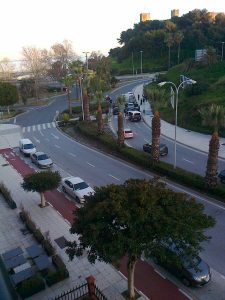 Police checkpoint in front of our apartment-hotel building across the street from the Sohail Castle.
Police checkpoint in front of our apartment-hotel building across the street from the Sohail Castle.
By contrast, thousands and even millions of Spaniards protest wars and inhumane treatment of refugees from the wars. Specific days for peace are also celebrated. One such march took place the same week we arrived in neighboring Benalmádena, a beach town the same size as Fuengirola, 70,000. 785 primary and secondary students of Jacaranda school, dressed in t-shirts with a peace design they chose—supported by parents, teachers, the mayor and town council—marched from the school to the main square. They read a manifest for peace, sang and danced, and released several peace doves. The town’s educational councilor praised the school for its 28th march, “for its values of peace and solidarity.”
I fumed at the war-makers some days but Jette pointed to the peace-makers. We relaxed during nearly daily walks through lovely towns. Like 70 million other tourist/vacationers, we marveled at the fabulous art works, the colorful nature, and relished the food, especially the abundant fresh seafood. Spain has 46 million citizens and permanent residents with the world’s largest numbers of restaurants and bars per inhabitant. Many Spaniards spend more time and income eating out than most other peoples. The free or cheaply prized tapas with drinks are also an attraction for travelers.
The few refugees, about 6000, however, have no resources to eat out. And the thoroughly corrupt People’s Party (PP) government of Mariano Rajoy Brey has declined to take on the 15,000 refugees from Greece and Italy that was agreed upon in 2015 as part of EU’s quota allotment.
We spent time on the sandy beaches, naturally, swimming and looking for the fascinating sea shells that seemed designed for beauty and utility. Many are sturdy and large enough to hold ceviche I make. I even caught a sea- bass casting from the beach, which is a favorite pastime and source of food for many Spaniards.
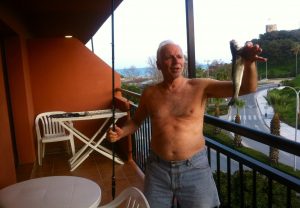 Me with my big catch on our balcony. The Sohail Castle tower is behind, and beyond the ever-so-blue Mediterranean.
Me with my big catch on our balcony. The Sohail Castle tower is behind, and beyond the ever-so-blue Mediterranean.
In Fuengirola, there are three archeological sites. (3) We saw where Romans in the Iron Age salted fish for consumption and export. In the same area close to the sea they made pottery and took their famous baths in tubs with cold, lukewarm, and hot temperatures. Wealthier bathers were massaged by their slaves. There were areas for concerts, a library and gardens. The thermal baths were owned by the state, which charged a small fee; children were admitted free. There were periods of unisex nudity but prudish Catholics outlawed this in the 3rd century AD by banning women from the baths.
Across the street from our apartment, on one side of Sohail Castle remains of Phoenician and Roman settlements from between 3000 and 2000 years ago have been uncovered. Many fossils were found but the dig stops where a manor stands complete with swimming pool and carports surrounded by a high wall and barbed wire. Why would this be here at an archeological park?
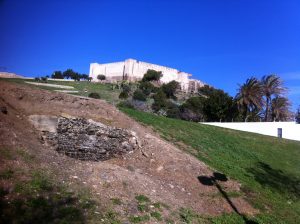 Private mansion, Villa Valsurbio, wall on the right stops the scientific dig. The ancient Moor castle is on top of the hill.
Private mansion, Villa Valsurbio, wall on the right stops the scientific dig. The ancient Moor castle is on top of the hill.
I asked several workers and pedestrians in the area about this. Most of them knew it had to do with Franco’s time. One told me, “The rich are the power not the law”. But unlike in most of the centuries of regular corruption—from the early kings, through colonization, the Franco period, and up to recently—there is action against it.
Spain has a long history of corruption—defined as managing public resources for private interests, and includes bribery. The English expression “Spanish practices” stems from a long history of “Spanish duplicity”. Most dishonest politicians, civil servants, and public and private functionaries get away with it. But since the economic crises with a 25% loss of employment, many people are acting. Activist protestors have been effective, and a former civil servant whistle-blower, Ana Garrido has revealed much corruption, which the mass media is finally covering.
Since 2010 there have been regular revelations of official corruption by top politicians especially of the People’s Party, including the president of Madrid region and ministers. The PSOE (Spanish Socialist Workers Party), and many businessmen have also been caught in corruption cases: kickbacks, bribes, tax fraud, public funding for work not performed or overpriced. Just between mid-2015 and the end of 2016, 1,700 people faced prosecution for corruption. Although 1000 town councils of the 8,100 in Spain have initiated corruption investigations, only 20 persons have been sentenced to prison. Despite transparency campaigns and promises, fiscal laxity remains endemic. Some investigators, for instance, are paid as much as 100,000 Euros annually, enough to look the other way.
Bankia, a major bank, is one of many cases unfolding. Twenty seven leading bankers and politicians are on trial for various acts of corruption and bribery. Another case, Gürtel network, involves 200 businessmen and public officials, including three former PP treasurers, charged with such crimes. The Prime Minister is called to testify in this case. The key man in the billion dollar scandal is known as Don Vito from the “Godfather”—construction capitalist Francisco Correa.
Then there is the infamous case of the king’s brother-in-law, Inaki Urdangarin. He was sentenced to six years and three months in prison while we were there. He was found guilty of masterminding a scheme for the Nóos Institute to obtain public contracts without bidding, in which no work was performed or done so at overpriced costs. He is also guilty of diverting public funds for personal profit. His wife, Cristina de Borbón, the former King Juan Carlos’ daughter, was fined 265,088 Euros for tax fraud complicity. Somehow, she was not found guilty of any crimes. This is the first time any member of the royal family has been so judged. King Juan Carlos stepped down in 2014 when the case began. His son Felipe took his place. Urdangarin, a former handball star player, appealed the sentence and is free on bail in Switzerland.
Due to these exposures the PP has ruled without a majority vote for the past two years. Its coalition government garnered only 33% in the 2016 election; 28% in 2015, compared with 44% in 2011. But the PSOE is not as favored as it once was either, winning only 22.6% in the 2016 elections compared with 44% in 2008. This has caused the national government, and many regional ones, to attempt to appease the people by ascribing to transparency. City councils are accepting complaints of all sorts and investigating them. Results of the investigations are publicized. When I found out about this, I decided to look into the private mansion background and make a complaint.
Dictator Francisco Franco gave José Antonio Girón de Velasco permission to build this mansion (Villa Valsurbio). Girón had faithfully served Franco in his illegal and brutal war against the democratically elected Republican government. He served as an officer in the 1936-39 civil war, and Franco made him his Minister of Labor, 1941-57.
Girón was a fanatic fascist. After moving into the mansion at the Sohail Castle, he started a tourist business and became known as “el león [lion] de Fuengirola”. Girón participated in the attempted coup of the democratic government in 1981. It failed, in part, because King Juan Carlos opposed it.
In my research, I found that Fuengirola had undergone an environmental impact study in 2008. The investigators had, in fact, pointed out that Villa Valsurbio is not in the cultural interests with the park or the archeological diggings. The study reports that “the rest of the surroundings [the private property] should be free space used by the public and the green zone.” I tried to find the investigators but they no longer held jobs or telephone numbers that they had in 2008. Nor could I find any response to the study by local authorities.
Girón died in 1995 and his family sold the house to another rich and politically connected man from out of town. I did not discover details of the current owner but I went to town hall to ask Mayor Ana Mula why the public park and archeological site is partially occupied by private property. I pointed out in my petition that her predecessor, Esperanza Oña, also of PP, had posted a plaque at the entrance of the park in 2002 dedicating it to the public in the name of a virgin. (I am uncertain if the virgin was meant to be the mother of Jesus Christ or another, because in the Spanish-dominated countries there are many virgins, officially speaking.)
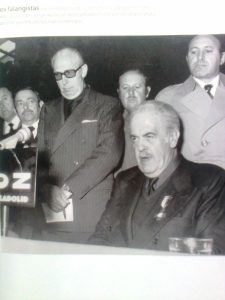 Fascists nostalgic for Franco, who died three weeks before this1975 photograph was taken. Girón is the leading figure sitting. We found this photo book, “The Transition”, published by the newspaper “El País”, at a café in Barcelona.
Fascists nostalgic for Franco, who died three weeks before this1975 photograph was taken. Girón is the leading figure sitting. We found this photo book, “The Transition”, published by the newspaper “El País”, at a café in Barcelona.
When I presented my complaint to city hall workers heads rose from computers. I filled out the transparency complaint form. I was assured that it would be answered. To date, I have no word from the mayor.
From our base in Fuengirola, we took day trips to the nearby colorful mountain town Mijas, the majestic Granada, Picasso’s Málaga and Antequera.
UNESCO has awarded Spain with 45 World Heritage Sites, the third highest number after Italy (51) and China (50). As it turned out we saw four of them: Granada’s Alhambra palace and Alcazaba fortress, Antequera’s dolmens, Atapuerca Mountains with its archeological sites and the unique Vizcaya Bridge in Bilbao.
Arab rulers held their capital seat in Granada during their reign in Andalusia. While the gardens and water ways are impressive and useful, the over-whelming buildings basically turn me off, as do most grandiose structures (pyramids, slaughter-house coliseums, gigantic city halls, manors, castles). They reek of bloody power hungry elitists who exploit workers and force slaves to build their symbols of domination. Private property is, in reality, the root of most of our man-made evils.
“Much of our present difficulty has been driven by the way humans have come to relate to space, objects and consistent imaginings we have about the world: we have come to think of these things as property. There is no natural reason for this. Property is purely a construct of the imagination and has no basis in the physical or living order,” wrote biologist and psychologist James Keye.
In contrast, I was quite taken by the dolmen gravesites in Antequera, or “Antikaria”—Old City in the language of Romans who settled in the area at the end of the early Iron Age. It was so named because of the ancient richness of the dolmens.
Three dolmens were built between 7000 and 5000 years ago for burials of leading citizen. More cadavers were also buried over many centuries. The structures are skillfully built for longevity. Much of the original stones remain today, both the interior structure as well as the mounds that cover them. The tombs, however, are not pompous, and everyone has used them to remember the dead and for collective religious ceremonies, even today. These unique monoliths were the first forms of monumental stone architecture in European pre-history.
The most fascinating is the Menga dolmen. It is a particular geographic landmark aligned with La Peña de los Enamorados (Lovers’ Rock). The long entrance faces this natural hilly formation as if to identify with it, to honor the apparent “sleeping face”, and as such it does not directly face the rising sun as was tradition for nearly all dolmen-makers.
We can’t know what the early Neolithic farmers and sheepherders called the hill, but honor it they did by aligning the five-chamber enclosure to face it. Menga’s construction is considered as significant as Stonehenge. Modern craftsmen are impressed by the 27.5-meter long, 3.5-meter high, 6-meter wide tomb with a 19.5-meter deep well where tools used to build it were found.
In medieval times, this 874-meter high hill was known as “The Indian of Antequera”. It was later given the name “Lovers Rock” because, as legend has it, a Christian woman and a Moor man fell in love. Multi-cultural love was forbidden so they fled to the hill. The woman’s father sent soldiers to capture them. As the soldiers approached, the loving pair threw themselves to their death.
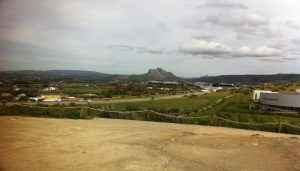 Me with the museum director at the Menga dolmen above, which faces the sleeping face on Lovers Rock below.
Me with the museum director at the Menga dolmen above, which faces the sleeping face on Lovers Rock below.
Notes:
(1) See Randy’s piece: http://www.counterpunch.org/2012/07/20/when-i-started-hating-america/
Regarding American Exceptionalism, John Pilger referred to President Barak Obama’s exclamation: “I believe in American exceptionalism with every fiber of my being”. This is what Pilger meant when he wrote, “American political life is a cultish extremism that approaches fascism.” See his piece, “The Issue is not Trump, it is us” https://www.counterpunch.org/2017/01/17/the-issue-is-not-trump-it-is-us/
(2) “How many Muslim countries has the U.S. bombed or occupied since 1980?” wrote Glenn Greenwald, November 6, 2014.Greenwald cited former army colonel Andrew Bacevich, who wrote that Syria had become at least the 14th country in the Islamic world that US forces had invaded, occupied and/or bombed, and in which US forces killed and/or were killed. And that was just since 1980. https://www.washingtonpost.com/opinions/even-if-we-defeat-the-islamic-state-well-still-lose-the-bigger-war/2014/10/03/e8c0585e-4353-11e4-b47c-f5889e061e5f_story.html?utm_term=.b8ff8d252546
Iran (1980, 1987-1988), Libya (1981, 1986, 1989, 2011), Lebanon (1983), Kuwait (1991), Iraq (1991-2011, 2014-), Somalia (1992-1993, 2007-), Bosnia (1995), Saudi Arabia (1991, 1996), Afghanistan (1998, 2001-), Sudan (1998), Kosovo (1999), Yemen (2000, 2002-), Pakistan (2004-) and now Syria.)
Nobel peace prize winner President Barak Obama, the hope of black and “progressive” Americans whom Colonel Bacevich supported in his first election, bombed seven Muslim countries plus Muslim areas of Philippines. Obama was the fourth consecutive US president to bomb Iraq. Look up on the internet for a “list of wars involving Spain.” It should not be surprising that “chickens come home to roost”.
(3) Fuengirola is said to have acquired its name after the Arabs were overthrown by Spanish Christians. Moors had called the town Sohail. The river flowing through the town, which empties into the Mediterranean, was once navigable and used especially by fishers. The hub of a boat is called a nave, as is the central passage of churches. The Spanish word for nave is “girola”. The Christians were mainly farmers and fishers and they went to church a lot. It became common to say that one went to fish on the river. The past tense of “to go” in Spanish is “fue”. So, one could say, “fue a girola”—I navigated the river or: gone fishing.
